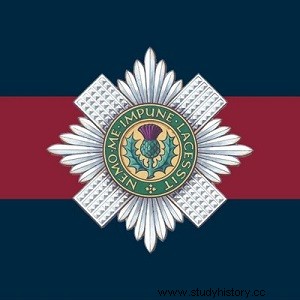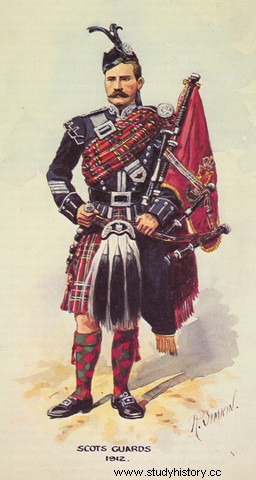
In the British army, the small Scottish military unit of the Scots Guards is one of the elite regiments making up the division of the British Royal Guard "the Guards Division", alongside the Irish Guards (North Irish, light infantry ), Welsh Guards (Welsh, infantry), Grenadier Guards (light infantry) and Coldstream Guards (English, infantry). Not to be confused with the Garde Écossaise, a former regiment of the French army (from the Middle Ages to the 19th century) made up of Scottish volunteers.
The Scots Guards are one of five infantry regiments of the British Sovereign's Guard (the Royal Foot Guards).
The Sovereign's Guard infantry consists of 5 regiments to 1 battalion:
The Grenadier Guards from the Regiment of Lord Wentworth, raised in 1656, responsible for the close guard of King Charles II then in exile in Belgium. The current name dates from 1877. It is the first guards regiment.
The Coldstream Guards, English guards created in 1661, from the regiment raised by General George Monck in 1659 in the town of Coldstream, on the border of England and Scotland. The current name dates from 1855. It is the second guards regiment.

The Scots Guards, Scottish guards, from the Royal Regiment of the Marquess of 'Argyll raised in 1642. The present appellation dates from 1877. It is the Third Regiment of Guards.
The Irish Guards, Irish guards, were created in 1900 as a reward for the bravery of the Irish during the Second Boer War in South Africa (October 9, 1899 to June 1, 1902). This is the Fourth Guards Regiment.
The Welsh Guards, Welsh Guards.
The first three regiments have an additional company which takes up the colors and traditions of the 2nd battalions which disappeared during the 1992 reform (N°2 Company, 2nd Bn Grenadier Guards (renamed Nijmegen Company), N° 7 Company, 2nd Bn Coldstream Guards and F Company, 2nd Bn Scots Guards). These three companies based at Chelsea Barracks in London are responsible for ceremonial and building security.
Their famous uniform includes a red tunic and a black bearskin cap (bearskin for officers) adopted in 1831. It was borrowed from the foot grenadiers of Napoleon I's Imperial Guard, defeated at Waterloo in 1815 by the 1st Foot Guards which subsequently took the name of Grenadier Guards.
The guards are differentiated by the color of the cap aigrette, the number and alignment of the buttons, as well as the collar insignia and the epaulets:
for the Grenadier:white plume on the left and buttons at regular intervals (because 1st foot regiment),
for the Coldstream:red plume on the right and buttons in pairs (because of the 2nd foot regiment),
for the Scots:no plume and buttons by 3 (because 3rd regiment on foot),
for the Irish:blue plume on the right and buttons by 4 ( because 4th foot regiment),
for the Welsh:green and white plume on the left and buttons by 5 (because 5th foot regiment).
History
Its origin comes from the Scottish Guard which was formed from the King's bodyguards, during the reign of Charles I (both King of Scotland and King of England) in the 17th century. The first mentions appear in 1642 (raised by Archibald Campbell, 1st Marquess of Argyll) in the context of the English civil wars (First English Revolution) and Anglo-Scottish (Conventionary Movement). In 1650 it took the name of Lyfe Guard of Foot during the reign of Charles II and it was institutionalized in 1686, as a Scottish unit established in England, under the title of Scottish Regiment of Foot Guards. The regiment's final name of Scots Guards was fixed in 1877 by Queen Victoria.
During the 20th century, the regiment was successively based in England, Egypt, Hong Kong, then Germany; and the unit was also used for more special missions, such as in the political unrest in Northern Ireland. On July 1, 1997, the Scots Guards was the military unit that performed the ceremonial handover of Hong Kong to China. At the beginning of the 21st century, the regiment had 94 battle of honor citations (equivalent to French regiment "citations") since their origin.
Participation in the battles of the 17th and 18th centuries
War of the League of Augsburg:1695 recapture of Namur - first Battle Honor citation for the regiment.
War of the Spanish Succession:1710 Zaragoza, 1710 Brihuega (defeat).
War of the Austrian Succession:1743 Dettingen, 1745 Fontenoy (defeat), 1747 Lauffeld (defeat).
Seven Years' War:1761 Villinghausen.
American Revolutionary War:1777 Brandywine, 1778 Germantown, 1781 Guilford Courthouse, 1782 Yorktown (defeat).
Participation in the battles of the 19th century
Napoleonic Wars:1801 Alexandria (Egyptian campaign); 1809 Talavera, 1811 Barrosa, 1812 Fuentes d'Onor, 1812 Battle of the Arapiles, 1813 Nive (Spanish campaign); Waterloo (fighting at the Hougoumont farm) 1815 (Hundred Days campaign).
Crimean War:1854 Alma -where the regiment won its first Victoria Cross-, 1854 Inkerman.
Colonial wars:1882 Tel-el-Kebir (revolt of Arabi Pasha in Egypt); 1899 Modder River fighting (Second Boer War in South Africa).
Participation in the battles of the First World War
Western Front only:1914 Mons, 1915 Marne (Battle of Deux Morins), 1914 Aisne, 1914 Yser, 1914 Ypres -at the end of which the regiment will receive its first Victoria Cross of the war-, 1915 Loos, 1916 Somme, 1917 Third battle of Ypres, 1917 Cambrai, 1918 Second battle of the Aisne, 1918 crossing of the Hindenburg Line.
Participation in the battles of World War II
Western Front:Narvik 1940 (Norway Campaign); 1944 Mont Pinçon (Normandy countryside); 1945 reduction of the Venlo pocket (Liberation of Belgium and the Netherlands|Holland campaign, under Canadian command); 1945 crossing of the Siegfried Line and the Rhine, as far as Saxony (German campaign).
North African Front:Halfaya 1941 (defeat), 1941 capture of Fort Capuzzo, 1941 Siege of Tobruk, 1942 El Alamein; 1943 Medenine, 1943 Djebel Bou Aoukaz -where a posthumous Victoria Cross will be awarded for a suicide action- during the Tunisia Campaign.
Italian Front:1943 landing in Salerno, 1943 crossing the Volturno on the Viktor line, 1944 landing of Anzio (battles of Campoleone and Carroceto), 1944 Monte San Michele (Gothic Line).
Participation in battles since 1945
Cold War:1950-1960 Malaya guerrillas (Malaysian communist M.R.L.A. movement).
Indonesian-Malaysian confrontation:1964 Borneo operations.
Falklands War:1982 Mount Tumbledown -with the last bayonet charge in the regiment's history.
Gulf War:1991 (Operation Granby).
Features
.
The Scots Guards is today an armored motorized infantry regiment; composed of a single battalion (the 3rd), the regiment is based in Münster in Germany.
Like the other four guards regiments, it ensures the direction of the British sovereign's royal guard by annual rotation, after passing the colors at the time of the royal birthday (ceremony of salute to the Colors Trooping the Colour, which also includes the Horses Guards).
The anniversary of the regiment is celebrated on St. Andrews (patron saint of Scotland) on November 30; motto:Nemo Me Impune Lacessit. The regimental marching tunes (bagpipes) are:Hielan’ Laddie (charge) and The Garb of Old Gaul (parade). The regiment's nickname in the British Army varies, either The Kiddies or Jock Guards. On the uniform, unlike the regiments of Highlanders (The Royal Highland Fusiliers, The Black Watch, The Highlanders Seaforth and Camerons, The Argyll and Sutherland Highlanders), the kilt (patterned with the royal tartan of the Stuarts) is not worn in the Scots Guards by combat companies, but only by the pipers of the regimental band.
The current colonel of the regiment is the Duke of Kent.
